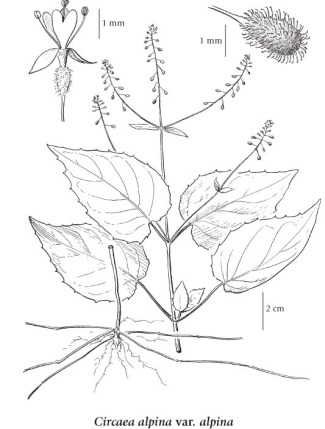Circaea alpina L. subsp. alpina
enchanter's-nightshade (small enchanter's nightshade)
Onagraceae (Evening Primrose family)
Introduction to Vascular Plants
enchanter's-nightshade (small enchanter's nightshade)
Onagraceae (Evening Primrose family)
Introduction to Vascular Plants
Map
Distribution of Circaea alpina subsp. alpina
Click here to view the full interactive map and legend
Species Information
General:
Perennial herb from a slender, tuber-tipped rhizome; stems erect, 10-50 cm tall, simple or branched, glabrous or appressed short-hairy.
Leaves:
Opposite, heart- to egg-shaped, 2-6 cm long, more or less entire to toothed, short-hairy on the lower surface, tips pointed; stalks 1.5-4 cm long, with narrow wings.
Flowers:
Inflorescence of terminal clusters of 8-12 flowers, often with 1 or 2 linear bracts at the base; flower stalks spreading to erect, becoming reflexed and about equalling the fruit; hypanthium 0.3-0.5 mm long; petals 2, white to pale pink, 1-1.5 mm long, erect, deeply notched; sepals 2, 1-2 mm long, bent downward; stigmas 2-lobed.
Fruits:
Capsules, top- or pear-shaped, about 2 mm long, hooked-hairy, 1-chambered; seeds 1, glabrous.
Notes:
Two subspecies occur in BC:
1. Stems glabrous; leaf bases heart-shaped; margins toothed; plants from throughout BC.................. ssp. alpina
1. Stems hairy; leaf bases from nearly heart-shaped to blunt; margins nearly entire to toothed; plants from coastal and S BC................... ssp. pacifica (Asch. & Magnus) Raven
Illustration

If more than one illustration is available for a species (e.g., separate illustrations were provided for two subspecies) then links to the separate images will be provided below. Note that individual subspecies or varietal illustrations are not always available.
Illustration Source: The Illustrated Flora of British Columbia
